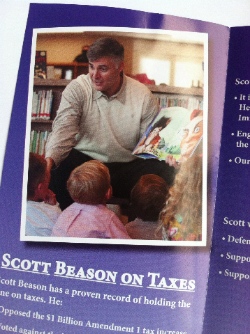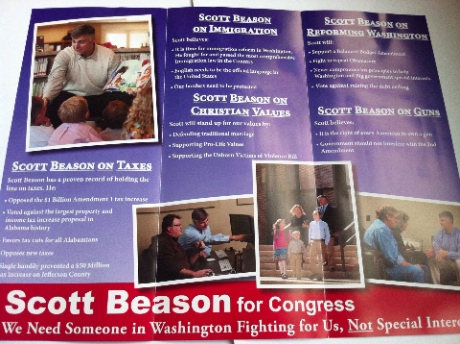Leaving political brochures on my doorknob is about as useless as trying to sell Avon products to the local Mary Kay sales rep. I’m certainly not buying, but I like to flip through the brochures and make fun of the attempt to sell to me.
When U.S. Rep. Spencer Bachus started having ethics problems last year, other Alabama Republicans smelled blood in the water. With the primary election only nine days away, State Sen. Scott Beason has emerged as the leading shark.
I haven’t looked at any polling and I don’t know how much money Beason has to spend, so I don’t have an informed opinion about whether he has a chance. My gut says he’ll probably lose, but that’s simply because an entrenched incumbent such as Bachus is hard to beat, even if he is a lightweight with no real credentials.
This is the first campaign cycle in more than 20 years when I haven’t done any work for a campaign, so it allows me to experience an election from the outside for the first time in a long time. It’s an interesting point of view. I’ve done hundreds of brochures and cards similar to the Beason literature that was hung on my door Saturday. So I’m going to invite you to take a look at a typical campaign piece — through the eyes of someone who used to write and design them.
The Beason brochure isn’t terrible and it isn’t great. It’s pretty garden variety as campaign literature goes. I guess that’s what makes this so interesting to me. You could change the name and photos on this brochure and use it for pretty much any conservative Republican district. (Change the wording and the issues and you could come up with a similar template for a typical Democratic district.)
It was about 10 years ago when I started getting really bored and disgusted with my political work. It had started before that, but I was feeling really cynical about it by then. I was shocked at the degree to which saying exactly the same things — regardless of candidate — was the way to get people elected. So I tried an experiment.
I showed a client a mailer that I’d done for a previous candidate and made sure that he liked it. Then I produced an identical piece for the new candidate. Other than the names and pictures and biographical information, it was about as identical as possible. The candidate’s positions and priorities were presented as exactly the same as those of the person for whom I’d previously written the words.
The candidate loved it. Nobody else ever noticed. And he won. Does anything else matter?
In a Republican district, we used the word “conservative” almost as though it was a magic incantation. You can see that Beason’s brochure prominently does the same on the front and back covers. Most Republican primaries in conservative states are all about who can claim to be the most conservative.
Let’s take a look at the photos. I laugh when I look at them, because they are identical to pictures I’ve taken and used of dozens of candidates. The cover shot is a standard head-and-shoulders shot. Nothing noteworthy there. But the shots inside are the ones I laugh about.
 One of the most typical and cliched shots in this sort of brochure is the one with the candidate reading to children. (See Beason’s version of it to the right.) I’ve done that shot over and over. Why? It implies that the candidate cares about kids, of course. It never really says anything concrete in particular, but the implication is that the candidate is a great guy who spends time volunteering at the local school or church working with children. I could quickly show you a dozen similar shots I’ve taken with my clients in the past, but I’m not going to do that to the people who’ve been nice enough to pay me good money over the years — but you know who you are.
One of the most typical and cliched shots in this sort of brochure is the one with the candidate reading to children. (See Beason’s version of it to the right.) I’ve done that shot over and over. Why? It implies that the candidate cares about kids, of course. It never really says anything concrete in particular, but the implication is that the candidate is a great guy who spends time volunteering at the local school or church working with children. I could quickly show you a dozen similar shots I’ve taken with my clients in the past, but I’m not going to do that to the people who’ve been nice enough to pay me good money over the years — but you know who you are.
Another favorite shot is the one of the family coming out of church together. Family shots are frequently fun because some of the families don’t get along nearly as well as we pretend. One candidate who I did several successful races for had a family who got along so poorly that family photo shoots turned ugly, one time turning into a shouting match. But we still came up with a nice shot of everyone smiling and happy. Why? It implies that the candidate is a wonderful family man who’s adored by those around him. (The family shot for a female candidate has to achieve something slightly different, but it’s not the case I’ve had to deal with as frequently.)
Then there’s the shot of the candidate sitting or standing with typical voters, listening to their concerns and explaining how he’s going to fix everything. (The example in the Beason brochure is on the bottom right of the inside of the brochure. See the picture at the bottom.) This kind of shot shows the candidate as active and engaged with voters or constituents. You sometimes see this shot over the shoulders of the people the candidate is talking to. That was one of my favorites because it allows getting closer on the candidate’s face, looking concerned and engaged.
Then there’s the businessman-type shot. It seems to show the candidate actively engaged in something productive. You’ll also frequently see the candidate pointing at something, beccause that shows that he’s proactive. He’s the one pointing something out to the poor underling.
Let’s talk briefly about the copy. You’ll notice that it doesn’t say anything specific about most issues that actually matter. You won’t find a word about how to deal with the national debt or cutting spending or defusing the ticking time bomb of entitlements such as Social Security, Medicare and Medicaid. No, those programs are popular, so they aren’t mentioned — even though anybody with a brain knows they have to be brought under control.
There’s mention of support for a “balanced budget amendment,” but we all know that’s not going to be enacted and it doesn’t say how he would favor achieving a balanced budget anyway. Would he cut the military? Of course not. Would he cut Social Security, Medicare and Medicaid? Highly unlikely. Would he favor higher taxes to balance the budget? Of course not. So how does he propose to balance the budget? Magic pixie dust? We don’t have a clue from what he says here.
Instead, the brochure hits on key words that Beason’s polling almost certainly tells him are the hot-button issues to the people of the district. The whole thing can be summarized as anti-taxes, anti-immigrants, pro-religion, pro-guns and anti-DC Establishment.
At the bottom of the inside, we have the implied assurance that Beason is for “us” — whoever “us” really is — instead of “special interests.” And who are special interests? They’re whoever we disagree with, of course. It’s one of the most common political terms today, but it means nothing, because your special interest is my “national interest.” And vice versa. But we’re all against “special interests” anyway.
And this is how we select political leadership in this country. Why? Simply because it works. Any political consultant worth his salt could have designed and written this brochure with no input from the candidate, because the things we say about candidates have far less to do with the candidates than with what the targeted voters want to hear.
As long as garbage such as this wins races, politicians will continue doing it. I don’t blame the candidates. I blame voters, because when candidates tell the difficult truths that voters don’t want to hear, they lose.
A candidate can either tell the painful truths that people don’t want to hear — and lose — or he can give people the buzzwords they want to hear — and win. Which do you think he’s going to do?
It’s not surprising that candidates do this. It’s only surprising that voters fall for it each time and reject the candidates who tell the truth instead. Of course, this is why serious, well-funded candidates don’t tell the truth. They know it will cause them to lose.
If you’re the average voter and you want to know who’s to blame for the pathetic politicians who are full of bombast and idiocy and fairy tales, look in the mirror. You’re the one who puts them into office. You’re the ones who fall for the garbage that I spent 20 years producing.

 Modern search for sexual pleasure slowly destroys genuine intimacy
Modern search for sexual pleasure slowly destroys genuine intimacy Conservatives don’t understand liberal groups — and vice versa
Conservatives don’t understand liberal groups — and vice versa My mother was more impressive than my father led me to believe
My mother was more impressive than my father led me to believe